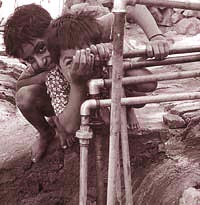Children Act Fast...So Do
Poisons! Consider this. About 40 to 65 per cent of all poisonings occur in
children. Out of these, nearly 90 per cent are preventable. Pesticide residues, lead,
asbestos, chemical contaminants found in water, air and food and in products found in the
home–all produce adverse effects on the health and development of children. Consider this. About 40 to 65 per cent of all poisonings occur in
children. Out of these, nearly 90 per cent are preventable. Pesticide residues, lead,
asbestos, chemical contaminants found in water, air and food and in products found in the
home–all produce adverse effects on the health and development of children.
The most common chemicals are found in commercial products, pharmaceuticals and natural
toxins (plants) available in the home and surroundings. Among the most dangerous household
products are bleaches, strong detergents and oven cleaners containing sodium hydroxide.
These when ingested, produce corrosion of the digestive tract. Inadvertent ingestion of a
drain cleaner or crystallised caustic soda commonly found in the kitchen requires repeated
surgery and years of rehabilitation. Kerosene is the most commonly ingested (and inhaled)
product worldwide. Its inhalation may produce chemical pneumonitis, secondary infection
and eventually, respiratory failure in children. The less toxic commonly ingested
household products are window cleaners, stain removers, shampoo and cosmetic products.
Children also get exposed to various pesticides, which are present in the home
environment. In most of the houses, at least one pesticide product is stored in
containers, which are well within the reach of young children. Exposure to pesticides can
lead to headaches, dizziness, muscle twitching, weakness, tingling sensations, and nausea.
Poison Control Centres play a critical role in the identification, management and
prevention of these types of exposure. Educating parents about preventive aspects and
common precautions that ought to be taken is a very important role of the Poison Control
Centre. These centers are thus in a position to play a potential "sentinel" role
in children’s environmental health.
A Poison Control Centre is to be initiated soon at the Sir Ganga Ram Hospital, New
Delhi. Suresh Gupta, Consultant at the Department of Pediatric Emergency Medicine and
Toxicology is also working on poison prevention, knowledge and practices among
pediatricians.
Those wanting to join hands with him, can contact Suresh Gupta at:
Sir Ganga Ram Hospital, New Delhi 11 060.
Ph: 5762672/73/74 Mobile: 09810124391
e-mail: drguptasuresh@yahoo.co.in
LEADing
problem

SANJAY ACHARYA/ EARTHSCAN
|
Amongst the most serious environmental toxins , lead ranks
as number one. The sources of exposure to lead include automobile exhaust, leaded pipes,
lead solders in water supply systems, and lead based paint, cosmetics (surma), medicines,
etc. Young children and developing fetuses are known to absorb lead more readily than
adults. It stays in our bodies, in blood, bones, and soft tissues, and can hurt kidneys,
liver and the nervous system. Exposure to low levels of lead can permanently affect
children. In low levels, lead can cause nervous system and kidney damage. Learning
disabilities, attention deficit disorder, and decreased intelligence. High levels of lead
can have devastating effects on children, including seizures, unconsciousness, and, in
some cases, death.
Between 1997-1999, a major screening program called
"Project Lead Free" was carried out by The George Foundation (TGF), a
non-governmental organization, to determine the blood lead levels among the population in
seven major Indian cities (Bangalore, Kolkatta, Chennai, Vellore, Hyderabad, Delhi and
Mumbai). This study of over 15,000 children and 5,000 adults clearly indicated an
environmental health crisis; it concluded that over 50 per cent of the children below the
age of 12 years living in urban environments had unacceptable blood lead levels of 10
µg/dl or more. Further 14 per cent of the children in these cities have seriously
elevated levels of lead of 20 µg/dl or more.
To inform, educate and communicate to the general public about this preventable
environmental health hazard, The National Referral Center for Lead Poisoning in India
(NRCLPI) was established as a joint project of St. John’s National Academy of Health
Sciences (SJNAHS) and The George Foundation, both from Bangalore. Besides providing
updated information on all aspects of lead poisoning, it offers blood lead testing
facilites for samples received at the Centre from anywhere in India. NRCLPI also
undertakes training of doctors and paramedics with regards to assessment and evaluation of
lead poisoning, provides consultancy services and makes policy recommendations to the
government for reduction and prevention of lead poisoning.
For more information, contact:
The George Foundation, No. 1155, 6th Main Road, IV Block, 1st Stage, HBR Layout
Bangalore 560 084
Phone: 080-2065058 Fax: 080-5520777
e-mail: nrclpi@leadpoison.net Website: www.leadpoison.net |

